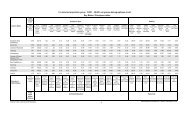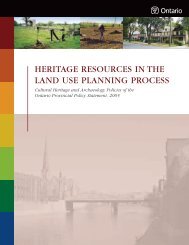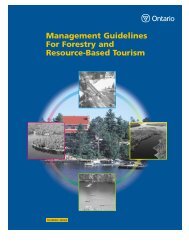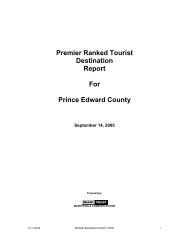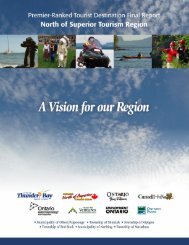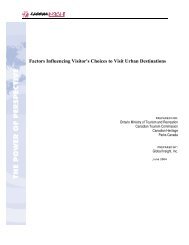Forest Operations on Crown Land - Ministry of Tourism
Forest Operations on Crown Land - Ministry of Tourism
Forest Operations on Crown Land - Ministry of Tourism
- No tags were found...
You also want an ePaper? Increase the reach of your titles
YUMPU automatically turns print PDFs into web optimized ePapers that Google loves.
necessary and a buffer z<strong>on</strong>e must be established with a radius <strong>of</strong> at least 200 metresfrom the estimated center <strong>of</strong> the site.Alternatively, a Stage 3 archaeological assessment may be undertaken to define thespatial boundaries <strong>of</strong> the site and determine its cultural heritage value or interest, afterwhich a buffer z<strong>on</strong>e <strong>of</strong> 10 metres from this boundary can be established. Stage 3assessment may also find that the site has been sufficiently documented and is <strong>of</strong> n<strong>of</strong>urther cultural heritage value or interest and will not require protecti<strong>on</strong>.Finally, a Stage 4 excavati<strong>on</strong> may be carried out to completely document and removethe site, allowing normal forestry operati<strong>on</strong>s to proceed.If the impacts to an archaeological site are not mitigated through complete excavati<strong>on</strong> <strong>of</strong>the site, the use <strong>of</strong> the buffer z<strong>on</strong>e will ensure the protecti<strong>on</strong> <strong>of</strong> the archaeological siteduring forest operati<strong>on</strong>s.6 Avoidance <strong>of</strong> archaeological sites during forest operati<strong>on</strong>s<str<strong>on</strong>g>Forest</str<strong>on</strong>g> resource licence holders will <strong>of</strong>ten opt not to harvest in areas where archaeologicalsites have been identified during Stage 2 archaeological assessment. The sites will beavoided during forestry operati<strong>on</strong>s. As a result, many archaeological sites identified duringassessments for forest management plans will not require Stage 3 testing as they will beavoided up<strong>on</strong> identificati<strong>on</strong>.If it is decided that Stage 3 will not be carried out at a site because the site will be avoided,the c<strong>on</strong>sultant archaeologist is required to document the results <strong>of</strong> the Stage 2 assessmentin a Stage 2 report. The report must include a descripti<strong>on</strong> <strong>of</strong> any archaeological resourcesthat were identified and recommend a strategy to avoid impacts to the identified sitesaccording to the standards described in Secti<strong>on</strong> 3.2 <strong>of</strong> the MNR <str<strong>on</strong>g>Forest</str<strong>on</strong>g> Management Guide forCultural Heritage Values (2007).7 Engaging Aboriginal communities in archaeologyArchaeology in Ontario is particularly relevant to Aboriginal communities because it canhelp to document Aboriginal histories and peoples and to identify sacred sites andancestral remains. Engaging Aboriginal communities in archaeology adds to theunderstanding <strong>of</strong> the impact <strong>of</strong> a project and enriches the archaeological record. Theengagement process dem<strong>on</strong>strates respect for Aboriginal heritage, recognizes Aboriginalpeoples’ c<strong>on</strong>necti<strong>on</strong> to the land, and allows every<strong>on</strong>e to gain a better understandingthrough that process.Archaeological Assessments for <str<strong>on</strong>g>Forest</str<strong>on</strong>g> <str<strong>on</strong>g>Operati<strong>on</strong>s</str<strong>on</strong>g> <strong>on</strong> <strong>Crown</strong> <strong>Land</strong>s | 10


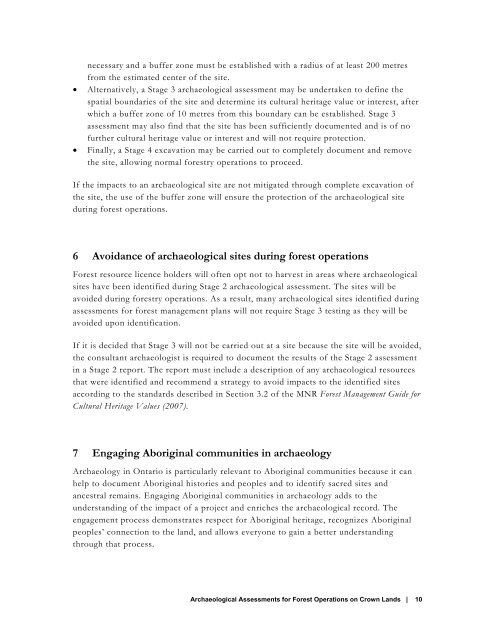
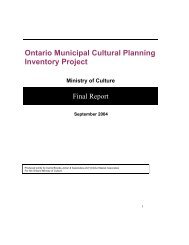
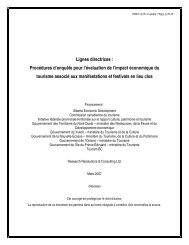
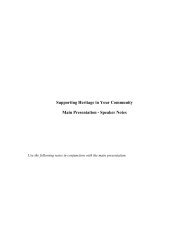
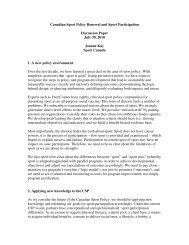
![THIS AGREEMENT made this [date], between [name of owner] (the ...](https://img.yumpu.com/49827605/1/158x260/this-agreement-made-this-date-between-name-of-owner-the-.jpg?quality=85)

